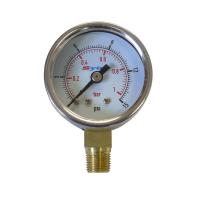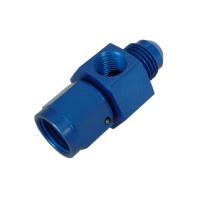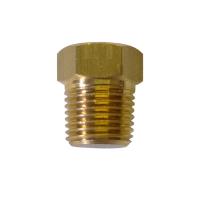We're often asked how fuel pressure can be monitored when tuning or fettling engines. There is not really a straightforward, single correct answer, as nearly every race car or kit car has it’s fuel system plumbed differently. But we thought at least if we pointed out some of the essential parts used, this would be a good guide or starting point.
Running the correct fuel pressure is essential for an engine to perform correctly and at it’s optimum. Normally fuel pressure is set when engines are new or first installed, and then does not need to be adjusted afterwards. The following parts make monitoring fuel pressure easier.
Firstly, a split needs to be made in the fuel line where the pressure is to be measured from. Depending how the fuel lines are plumbed will impact which fittings are required. Likewise, some fuel pressure regulators have a port in them, so a gauge can be fitted directly in, negating the need for a T-Piece.

Part number FGA100 (on the left in this image) is a T-Piece to suit 8mm (5/16 Inch) bore pipe. The fuel pipe is cut, then this T-Piece is inserted to act like a hose joiner. There is a 1/8NPT female port in the body of the T-Piece which enables you to fit the fuel pressure gauge.
Part number FGA100D (on the right in this image) is a similar T-Piece, but this one has three 1/8NPT female ports, meaning it can be used with different size fuel pipe with the aide of adaptors, so can be fitted to 6mm or 10mm bore pipe for example.

Once pressure monitoring is required, the small brass plug is removed from the T-Piece and the pressure gauge is fitted. These T-Pieces and gauges use 1/8NPT tapered threads, so the gauge does not screw all the way in to the T-Piece, and sometimes PTFE tape or thread sealant is required to seal.
In this instance, we are showing FPG001 Gauge which reads from 0 to 15PSI (0-1 Bar) and so is suitable for use with carburettor or other low pressure readings.
Once the pressure has been set to the desired rate, the gauge can be removed and the plug refitted until the next time pressure needs to be inspected.
Click here for - the FGA100 T-Piece
Click here for the FPG001 Gauge
Other plumbing options include T-Pieces with threaded unions, such as -6JIC which is commonly used in fuel systems. These enable fitting into Goodridge 200 or 811 Series hoses for example.

Goodridge part number FP190 (on the left in this image) has two -6JIC male threads and then a 1/8NPT female port in the side.
Goodridge part FP192 (on the right) has a -6JIC male thread and a -6JIC female thread, meaning it can be fitted straight on to a -6JIC fuel rail for example. This also has 1/8NPT thread in the side.
Click here to see - the FP190
Click here to see - the FP192

In this image, we show part number FPG002 fitted to the FP190 Goodridge fitting. The FPG002 gauge reads from 0 to 100PSI (0-7 Bar) so is suited for higher pressure applications such as fuel injection. This gauge is liquid filled in order to dampen the needle and give an accurate reading. As before, once setting of pressure is done, the gauge should be removed and a blanking plug fitted back in to the T-Piece.
Click here to see - the FPG002 gauge
Click here to see - the blanking plug
There are also many other ways of measuring fuel pressure such as permanently fitted gauges in dashboards. Please do not hesitate to contact us for advice on best parts for your particular needs.











